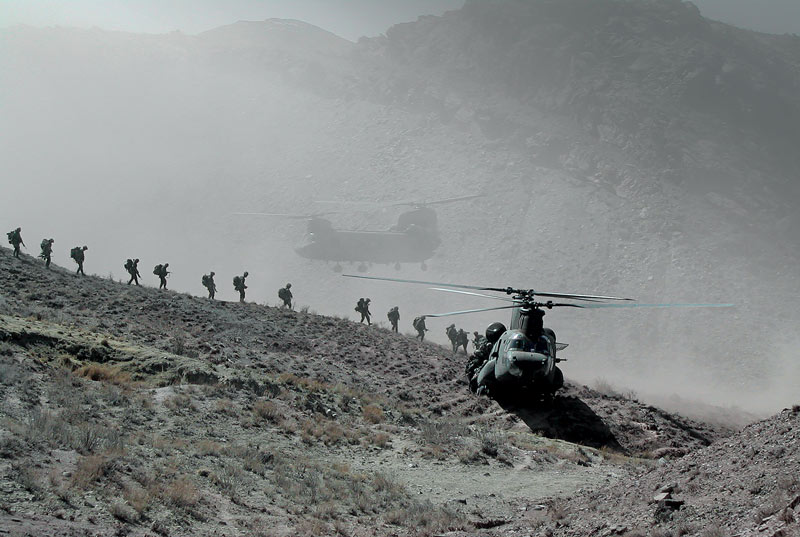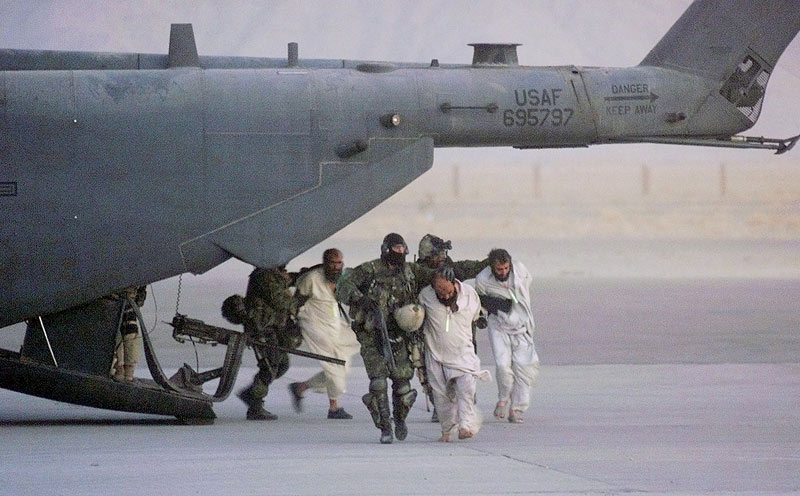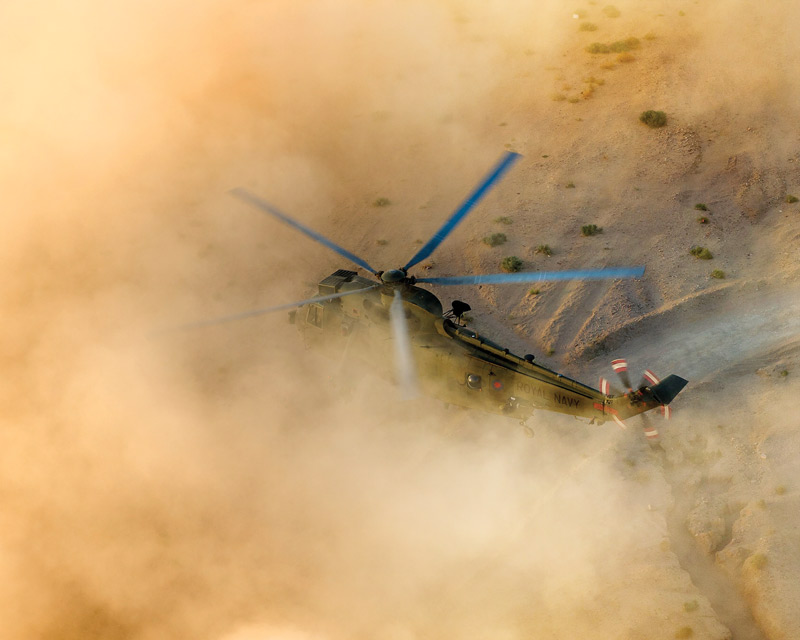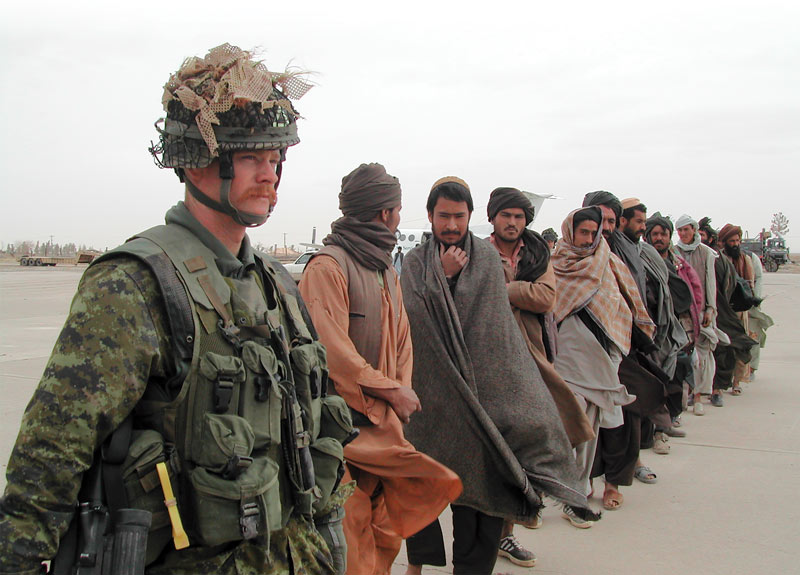The 9/11 attack triggered an international response, and Canada was quick to join the fight

Canadian troops board a U.S. Chinook in the mountains of Eastern Afghanistan on March 17, 2002, at the end of their first combat offensive since the Korean War. The four-day operation was a harbinger for what was to come. [Stephen J. Thorne/The Canadian Press]
Many Canadians learned their soldiers were fighting a war in Afghanistan when an Associated Press photograph appeared in newspapers across the country showing masked members of Canada’s elite special forces unit hustling three detainees off the back of an American MH-53J helicopter.
It was Jan. 21, 2002, and some 40 highly trained commandos of Joint Task Force 2 (JTF 2) had been operating in-country since at least Dec. 5. Even the prime minister, said some reports, wasn’t informed of their deployment until sometime after the fact.
Still, the preponderance of Canadians didn’t seem surprised. Those who were paying attention would have known by late December that something was afoot, but most appeared more concerned with the fact the Canucks in the picture were wearing their new woodland green fatigues instead of desert brown.

Canadian special forces troops hustle three enemy detainees off the back of a U.S. helicopter at Kandahar airfield in southern Afghanistan on Jan. 21, 2002. [Dario Lopez-Mills/The Associated Press]
Canada’s presence in Afghanistan, at least initially, wasn’t at issue. Nearly 3,000 people died after 19 al-Qaida terrorists hijacked and crashed four airliners in the United States on Sept. 11, 2001.
More than 6,000 others were injured in the attacks on New York’s World Trade Center and the Pentagon in Washington. One plane never reached its target: everyone aboard United Airlines Flight 93 died when it was forced down in a Pennsylvania field en route, it is believed, to the White House, 30 minutes away.
The victims of 9/11 hailed from more than 90 countries, including 24 from Canada. Some of their remains were still being identified 18 years later.
It was the deadliest terrorist attack in history, and the fallout from it continues two decades later, even as America withdraws from its longest war with the outcome still unresolved.
Allies rallied behind the U.S.—the only time North Atlantic Treaty Organization members have invoked Article 5 of the North Atlantic Treaty, which declares that an attack on one is an attack on all.
More than 40,000 Canadians served in Afghanistan before it brought its forces home in 2014. Canada lost at least 158 soldiers in Afghanistan (JTF 2 casualties are unclear), along with seven civilians. Officially, some 2,000 Canadian military were wounded, though the actual figure is believed to be much higher.
In fact, the war’s toll on Canadian veterans and serving military is still mounting, primarily due to post-traumatic stress disorder and associated suicides numbering in the dozens. What amounted to a postwar mental health crisis focused unprecedented attention on PTSD and inspired new treatments and strategies. Judging from the obituaries and tributes that keep appearing on social media, the epidemic continues, largely unabated.
Afghanistan marked the first time since Korea 50 years previous that Canadians were seen to be fighting an offensive war. The initial public support was heartening to many a soldier who had felt the shame of the 1993 Somalia affair and laboured long under the frustrations and relative obscurity of peacekeeping service.
From the start, the work of Canada’s JTF 2 went unrecognized among the general public, due largely to the small force’s obsession with secrecy and anonymity. Relatively obscure, even in the political and military spheres, it would emerge as one of the world’s best special operations units.
Osama bin Laden’s al-Qaida had allied with Afghanistan’s radically fundamentalist Taliban regime. It brought back the country’s opium poppy industry and used the profits to train an army of terrorists, culminating in the 9/11 attacks.
JTF 2 landed in the midst of the fighting for possession of Kandahar.
In the first operations after that fateful day, American special ops forces linked up with the Afghan Northern Alliance and famously fought battles on horseback as they pushed south.
Much of the al-Qaida training had been conducted at a compound a stone’s throw from the airbase where the Canadians were now taking up residence alongside their coalition partners.
JTF 2 landed in the midst of the fighting for possession of Kandahar, the Taliban’s birthplace. They operated for 11 months alongside 1,300 of their elite brothers-in-arms from the U.S., Britain, Australia, New Zealand, Germany, Denmark, Croatia and Turkey. The first special ops force was known as Task Force K-Bar.
Their U.S. commanders knew little of JTF 2’s capabilities at the outset and the Canadians were initially marginalized, retired colonel Bernd Horn wrote in his paper, We Will Find a Way: The Canadian Special Operations Legacy, published on commission by the Canadian Special Operations Forces Command in 2018.
The Americans were “curious because they didn’t really know us,” a JTF 2 soldier told Allan Woods of the Toronto Star in 2010. “At the beginning, people said, ‘Who the fuck is JTF 2?’”
It took only one mission to establish their bona fides.
That mission, Woods wrote, paired six Canadians with six U.S. Green Berets in a raid on a suspected enemy compound. It nearly cost all of them their lives—coming and going.
Flying with their American brethren aboard a Chinook, they landed in a swirl of the powder-light dust ubiquitous to the region. The whirling helicopter blades caused what’s known as a brownout, a blinding and aeronautically compromising phenomenon that would eventually become a $100-million-a-year problem for the U.S. military in Iraq and Afghanistan. By 2005, brownouts had claimed more choppers than all other threats combined.

A Royal Navy Sea King contends with brownout during a 2013 desert landing in Jordan. [Mez Merrill/RN/MoD/CH1300610172/Wikimedia Commons]
Instruments aboard the bird on that December night indicated it was still 15 metres above the ground when it landed—hard—and 600 metres from the high mud walls of their objective.
The coalition soldiers made their way over, blasted through the obstacle and quickly took control of the compound. The Americans discovered and destroyed a stockpile of weapons. The Canadians searched the main building and emerged with a computer hard drive, which was later turned over to U.S. analysts.
The Americans would eventually tell them that what they’d found on that drive proved far more valuable than anything else discovered that night.
Back aboard the chopper, halfway to a U.S. airbase in Pakistan, the American pilots were running dangerously short of fuel. It took a last-minute, rarely employed, air-to-air, fixed-wing-to-helicopter refueling operation to get them safely “home.”
K-Bar commander Captain Robert Harward, a U.S. Navy Seal, was impressed. He described that initial JTF 2/Green Beret op as “the first coalition direct action mission since the Second World War.”
K-Bar was disbanded in April 2002. By the time JTF 2 left the following November, they had become a go-to force of specialized fighters conducting, by U.S. military assessment, 42 reconnaissance and surveillance missions and 23 direct action (combat) missions—more in total than any other coalition special ops force.
Their jobs included “snatching senior Taliban officials, manning high-altitude observation posts, and combing mountain cave complexes,” said the U.S. defence department document.
“Their performance earned them the trust and respect of the U.S. commanders in theatre and the [unit] was given special tasks with American subunits,” including the 75th Ranger Regiment and paratroopers of the 82nd Airborne Division, wrote Horn.
“We challenged our operators to conduct missions in some of the most hostile environments ever operated in,” said U.S. Navy Commander Kerry Metz, director of operations for Task Force K-Bar at the time.
“For example, we had special reconnaissance teams operating in the mountains of Afghanistan above 10,000 feet for extended periods without resupply.”
JTF 2’s first deployment in the post-9/11 war on terror (there would be more) helped to capture 107 and kill at least 115 Taliban and al-Qaida fighters, including key leaders. JTF 2 commandos were wounded in action, some seriously, but the service has never acknowledged any deaths from that period.
The only JTF 2 member whose death was announced was Master Corporal Anthony Klumpenhouwer, a signals technician from Listowel, Ont., who was killed in a fall from a communications tower in Kandahar in 2007.
In 2004, the Canadians and other K-Bar forces were awarded the Presidential Unit Citation, America’s highest unit award, for “extraordinary heroism and outstanding performance of duty in action against the enemy in Afghanistan.”
Soon after the AP photograph with the detainees appeared in 2002, Canada’s special operations troops largely dispensed with the formalities of uniforms—opting instead, as other commandos did, for generic tan along with beards, ballcaps and the requisite sunglasses.
They were in their element, and the experience, successes and failures of that first deployment informed and elevated the development of Canada’s special forces. JTF 2 would double in size over the next few years. Active since 2006, the Canadian Special Operations Forces Command now presides over an organization that also includes the Canadian Special Operations Regiment and 427 Special Operations Aviation Squadron.
“The year 2001 marked an important milestone in the history of JTF 2,” said a National Defence summary. “This deployment was the first time JTF 2 was used in a major combat role outside Canada.
“The unit played a critical role in coalition Special Operations Forces and earned the respect of Canada’s allies for its professionalism.”

A Canadian soldier stands guard alongside Afghan workers as they wait to unload sacks of grain from a World Food Programme relief flight at Kandahar airfield on Feb. 28, 2002. [Stephen J. Thorne]
Officially, the navy had been the first of the Canadian forces in theatre. They arrived in the Persian Gulf in early October as Operation Apollo, code name for the Canadian operation from 2001 to 2003, got underway. They escorted ships of the coalition and monitored the comings and goings of suspect vessels, boarding when needed.
Canadian Aurora patrol aircraft and Hercules and Polaris transports operated over Afghanistan and the waters off Southwest Asia, conducting marine surveillance, transporting supplies and personnel, and evacuating casualties.
Canadian snipers broke distance records and earned U.S. Bronze Star Medals.
Canadian helicopters were integral to the naval mission. Flying a newly acquired fleet of Chinooks, Canadian pilots later transported troops and supplies into and around Afghanistan itself, freeing the army from its sometimes-frustrating dependence on American aviation.
Regular troops began arriving in Kandahar in January. The bulk of Canada’s infantry force came in February from Edmonton and Winnipeg, along with armoured reconnaissance from Lord Strathcona’s Horse (Royal Canadians). They formed the 3rd Battalion, Princess Patricia’s Canadian Light Infantry (3PPCLI) Battle Group.
Commanded by Lieutenant-Colonel Pat Stogran, who took his orders from an American airborne general, they would see action in the mountains and valleys of eastern Afghanistan, where Canadian snipers broke distance records and earned U.S. Bronze Star Medals fighting alongside Americans.
In March 2002, some 500 Canadian infantry troops launched their first combat assault since the Korean War on a mountain known as the Whale’s Back.
The first four Canadians killed in Afghanistan—Sergeant Marc Léger, 29, of Lancaster, Ont.; Corporal Ainsworth Dyer, 24, of Montreal; and two privates from Nova Scotia, Richard Green, 21, of Mill Cove and Nathan Smith, 27, of Porters Lake—died April 17, 2002, by friendly fire when an American F-16 pilot mistook their nighttime live-fire exercise at bin Laden’s former training compound for enemy action and bombed them. Eight others were wounded.
Canada lost its first two regulars to enemy action on Oct. 2, 2003, when Sgt. Robert Short, 41, of Fredericton, and Cpl. Robbie Beerenfenger, 29, of Ottawa were killed by a landmine while on an Iltis patrol along a dry riverbed southwest of Kabul. Three others were wounded.
The understocked and undermanned army anchored Canada’s largest military deployment since the Second World War. Beleaguered Canadian soldiers have long tired of the adage “hitting above their weight,” but that’s what they did in Afghanistan.
Troop strength peaked at almost 3,000, and studies have found that the Canadians carried a heavier burden than most.
Twenty of the 47 non-U.S. coalition troops killed in action between February and September 2006 were Canadian, reported a paper by the Canadian Centre for Policy Alternatives. When adjusted for the relative numbers of troops on the ground, the study said, a Canadian soldier in Kandahar was nearly three times more likely to be killed by hostile action than a British soldier and 4.5 times more likely than an American.
“If the current rate of military deaths…were to remain unchanged until the end of the mission in January 2009,” it said, “the Canadian military would sustain another 108 military deaths, bringing the total number of military deaths for Afghanistan to 140, or four times higher than what is today.”
The mission, of course, was extended until 2014. The numbers speak for themselves.
The Canadian findings were reinforced in a May 2021 study by the U.S.-based Costs of War project, an ongoing series of detailed analyses conducted by experts at various institutions across the U.S. It is administered by Brown University’s Watson Institute for International and Public Affairs in Providence, R.I.
With 2,905 soldiers in-country, the report ranked Canada fifth of some 47 countries in the number of troops it had invested in the Afghanistan mission during the U.S. peak of 100,000 troops in February 2011. By percentage of population that contribution represents, Canada ranked third at .008, behind only the U.S. (.032) and the United Kingdom (.015).
The report also found that over the course of their involvement in the war, Canadians died in Afghanistan at more than twice the rate of their American allies—5.4 per cent of peak deployment to 2.3. The U.S. figure represents the more than 2,300 Americans killed in action; the U.K. came in at a rate of 4.7 per cent, or at least 450 killed.
“When we look at numbers of fatalities relative to the size of each country’s deployment, Canadian soldiers suffered the highest risk of dying,” wrote the report’s author, Jason Davidson, a political scientist at the University of Mary Washington in Fredericksburg, Va. “These numbers demonstrate that British and Canadian troops were not hiding from the fight—they put their lives at risk at twice the rate of American troops, when seen as a percentage of peak deployment.”
Canada also ranked high in total military spending in Afghanistan—roughly US$14 billion (C$18 billion) over the course of its involvement compared to US$730 billion by the Americans (to 2018) and US$28.2 billion by the U.K., which also withdrew in 2014.
Canada’s total military spending in Afghanistan is equivalent to 55 per cent of its 2018 defence budget, third highest among coalition countries. The U.S. figure represents 106 per cent of its 2018 defence budget, while the U.K.’s represents 56 per cent.
Canada also more than held its own in foreign aid to Afghanistan, which is now into its fifth straight decade of war. Ottawa spent US$2.42 billion helping Afghans through 2018, fourth in total expenditures behind the U.S., Germany and the U.K.
“From the outset,” noted the report, “the intervention had widespread international legitimacy, including United Nations Security Council authorization.”

Accompanied by armed JTF 2 commandos in sunglasses and business suits, then-prime minister Jean Chrétien visits Canadian troops at Camp Julien in Kabul on Oct. 18, 2003. [Paul Chiasson/The Canadian Press]
Not so, Iraq. There was little question that a Canadian presence in Afghanistan was justified and necessary, morally and politically. But then-prime minister Jean Chrétien drew the line when he refused to contribute forces to President George W. Bush’s unsanctioned venture to unseat Saddam Hussein. Dictated as much by a lack of resources as anything, it proved one of the long-serving PM’s wiser decisions.
Afghanistan transformed the Canadian military, in terms of practical experience and equipment and in the eyes of Canadians, who quickly came to appreciate their troops’ commitment and sacrifices.
While public and political pressure to end Canadian involvement came to bear as the years passed and casualties mounted, support for its fighting men and women never waned. A new era had dawned.
Advertisement





















